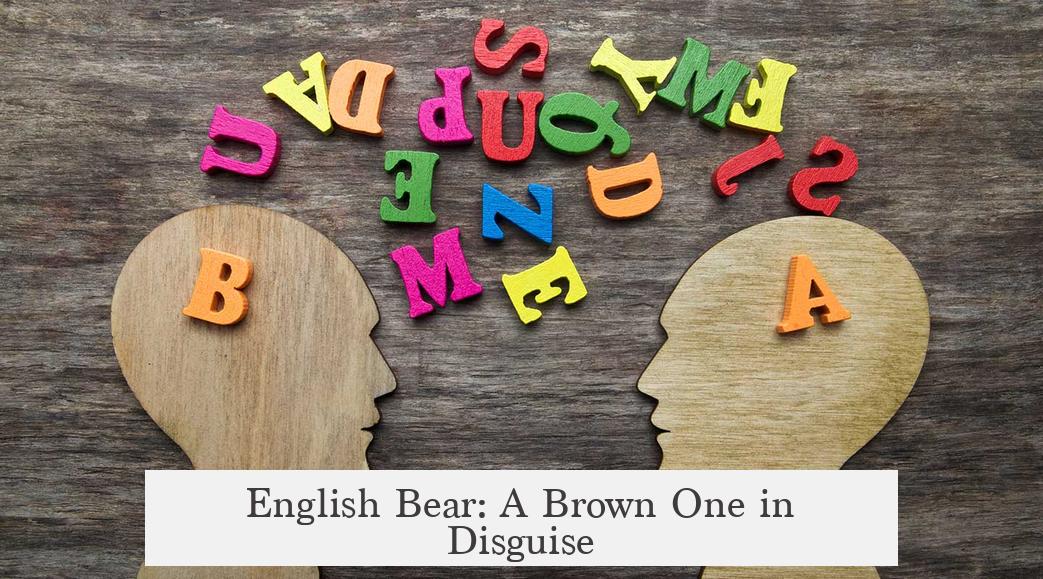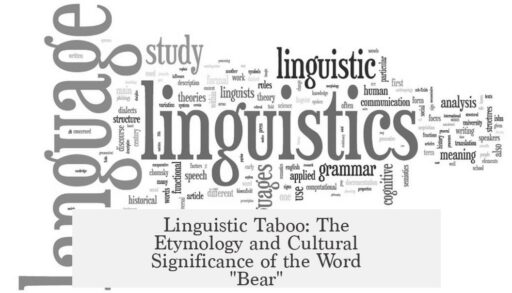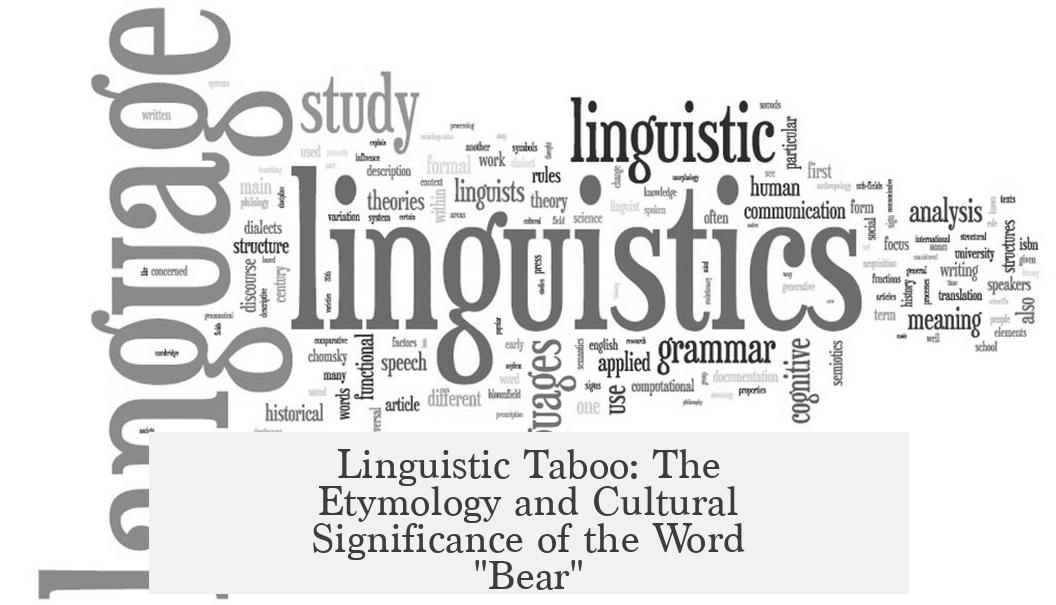The etymology of the word “bear” reflects a linguistic taboo rooted in prehistoric cultural practices. Early speakers avoided using the animal’s original name due to reverence and fear, substituting it with descriptive circumlocutions that indirectly referenced the creature. This practice aligns with broader traditions of noa (allowed) and tabu (forbidden) names observed across circumpolar and other cultures.
In many northern and circumpolar societies, the bear holds profound spiritual and cultural significance. People frequently gave the bear respectful treatment. This deference extended to language: the bear’s true name was often avoided to prevent offending the animal’s spirit. Instead, speakers used polite circumlocutions or noa names.
Anthropologists classify these linguistic behaviors using the Polynesian terms “noa” and “tabu.” “Tabu” refers to forbidden or inappropriate speech or actions, while “noa” denotes neutral or permissible alternatives. This system allows communities to maintain complex behavioral and verbal codes surrounding sacred or feared entities.
The English word “bear” derives from the Proto-Germanic root *beron, meaning “brown one,” clearly a descriptive substitution. The original term in Proto-Indo-European, reconstructed as *rkto, gave rise to words like Latin “ursus” and Greek “arktos.” Prehistoric English speakers likely replaced the original word to avoid directly naming the bear in speech, eventually forgetting that initial name altogether.
| Language | Bear Name Meaning | Nature of Taboo/Circumlocution |
|---|---|---|
| English | “Bear” from *beron, “brown one” | Color-based polite substitution |
| Russian | Medved, “honey eater” | Focus on dietary habit instead of animal itself |
| Swedish | Sötfot, “sweet foot” | Another polite, descriptive avoidance |
| Shoshoni (Native American) | “Our father’s sister” | Kinship term as respectful circumlocution |
| Finnish | Mesikämmen, “nectarpaw”; Karhu as noa word | Several respectful alternative names |
This linguistic avoidance mirrors broader cultural practices involving circumpolar bear cults. The bear is often seen as a sacred being with magical attributes. One widespread belief involves the bear’s paw being “honey-laden,” symbolizing its ability to survive winter by sucking on the paw’s nectar, thus accessing honey’s special powers. Due to this sacred aspect, parts of the bear such as the paw and claws—believed to carry magical potency—are highly prized.
Women in some groups were forbidden to consume bear paws, associating the prohibition with the mystical qualities attributed to them. The multiplicity of noa names for the bear across cultures illustrates how deeply entrenched the taboo was. Finnish, for instance, has numerous terms, highlighting the bear’s central role and the linguistic care exercised around it.
The concept of linguistic taboo and circumlocution extends beyond bears. Consider the word “elf,” originally linked to the shimmering appearance of supernatural beings. The term itself likely replaced a now-lost taboo word. Over time, other polite circumlocutions—like “good neighbors” or “fair folk” in English, “hulderfolk” in Scandinavian languages meaning “hidden folk,” and “sidhe” in Irish meaning “mound dwellers”—emerged to avoid invoking these entities directly.
These patterns reflect a wider human tendency to avoid direct naming of powerful, potentially dangerous, or sacred beings. Instead, indirect, respectful, and often descriptive terms are used. This practice serves social, cultural, and spiritual functions, ensuring respect and avoiding attracting unwanted attention.
- The English word “bear” is a result of linguistic taboo, replacing the original Proto-Indo-European root.
- Multiple cultures use circumlocutions or noa names for the bear, often describing its color, habits, or kinship roles.
- Circumpolar bear cults attribute spiritual significance to the bear’s paw and claws, influencing language and behavior.
- Linguistic taboo is common for supernatural beings too, as seen in the evolution of the word “elf.”
- This tabooinformed linguistic strategy preserves respect and mitigates fear of powerful natural and supernatural beings.
Is the Etymology of the Word “Bear” Actually a Linguistic Taboo?

Yes, the etymology of the word “bear” is indeed rooted in a linguistic taboo. Ancient speakers avoided saying the bear’s original name, likely out of deep respect and fear toward this powerful animal. Instead, they crafted polite circumlocutions or “noa” names to refer to it. This linguistic avoidance has left its mark on the English language and many others.
Let’s wade deeper into this fascinating story. Why would humans avoid saying a word for one of the most formidable creatures around? It turns out this is not just a quirky moment in English vocabulary but part of a widespread cultural and linguistic phenomenon across the circumpolar regions.
Bear Reverence and Linguistic Taboo: A Cultural Phenomenon

Anthropologists love to borrow the Polynesian words “noa” (allowed) and “tabu” (forbidden), which perfectly frame what happens with the bear’s name. Across the polar regions, indigenous peoples often showed the bear enormous respect, treating it almost like a supernatural being. Saying its true name was taboo because it might offend or attract the bear’s attention—something no one wanted to risk when dealing with such a large predator.
Instead of naming the bear directly, different groups employed circumlocutions. Think of them as polite sidesteps around a dangerous word. These noa names served to keep the bear appeased and avoided the risk of summoning it accidentally through speech.
English Bear: A Brown One in Disguise

The English word “bear” comes from the Proto-Germanic root beron, which simply means “brown one.” See, instead of calling it by its true name—which might have sounded like *rkto* (related to the Latin word ursus)—our ancestors opted for a descriptive euphemism based on the bear’s color.
This wasn’t unique. Many languages sidestepped the taboo original names by using descriptions or metaphors related to the bear’s traits or behavior. For example, the Russian word medved literally means “honey eater.” Clever, right? Why name the bear after a scary name when you could just call it by its favorite snack? Similarly, in Swedish, the bear is sötfot, “sweet foot.”
In Native American Shoshoni language, the bear is respectfully called “our father’s sister,” a familial circumlocution showing reverence. Finnish speakers have a delightful lineup of bear names, including mesikämmen (“nectarpaw”)—a noa word connected to the magical honey on the bear’s paws—which ties into ancient beliefs about the bear’s winter hibernation and mystical properties.
The Magical Honey-Laden Paw

Now, why the focus on honey? Various circumpolar bear cults believed that bears survive winter by sucking honey from their paws, which imbues them with magical endurance. Because of this, parts like the bear’s paw held sacred status. Women were sometimes forbidden from eating the paw meat, understood to hold these magical qualities.
It’s remarkable how such specific details survive in language and ritual. The noa names highlight not just linguistic playfulness but deep cultural respect and mythic thinking. Words and stories become shields, protecting people from potential harm and maintaining harmony with nature’s powerful spirits.
Circumlocutions Everywhere: From Bears to Elves
Bear names aren’t the only example of linguistic taboos shaping vocabulary. Consider “elf,” a word linked to the shining or shimmering nature of supernatural beings. Instead of using original, perhaps fearsome names, English speakers used “elf” and later alternatives like “good neighbors” or “fair folk” to speak cautiously of these beings.
Scandinavians called elves huldre, the “hidden ones.” Irish people used sidhe, referring to the fairy mounds they inhabited, and often resorted to gentle euphemisms like “wee folk” or “beautiful ones” rather than the actual feared terms. These linguistic detours remind us that words carry power and that taboo language exists all over the world.
Why Does This Matter Today?
Understanding that “bear” is the result of linguistic taboo changes how we think about language evolution. It isn’t just accidental or random; it reflects human psychology, respect, fear, and the way societies negotiate their relationship with nature.
Modern speakers probably take words like bear for granted without realizing these ancient respects encoded in our speech. This notion invites questions: Do we still practice linguistic taboos today? What words do we avoid and why? Could our modern euphemisms be the echoes of respect or fear applied in new ways?
Practical Tips for Language Lovers and Cultural Explorers
- When exploring old words, ask whether they might be noa words—careful circumlocutions born from taboo.
- Look for words based on color, behavior, or natural traits as euphemisms replacing dangerous or feared names.
- Explore indigenous or historical folk stories about animals, which often reveal why some names were avoided.
- Consider how modern language might still hold onto old taboos, like words around death, illness, or sacred concepts.
Studying these avoids enriches our cultural understanding and connects us to ancient wisdom embedded in everyday speech.
In Conclusion: The Power Behind the Word “Bear”
The English word “bear” hides a story of deep human respect and linguistic reverence. The word itself is a polite dodge around the original, now-lost term, a perfect example of linguistic taboo in action. This taboo pushed ancestral speakers to create noa words, names that softened and respected the power of one of their greatest wilderness neighbors.
Next time you say “bear,” remember you’re stepping into a long tradition of careful speech, cultural reverence, and storytelling. Language isn’t just about communication; it’s about survival, respect, and the unseen bonds humans forge with the natural world.
So, what unusual words in your language might be hiding an ancient taboo story? Food for thought, or maybe even a bear to ponder.




